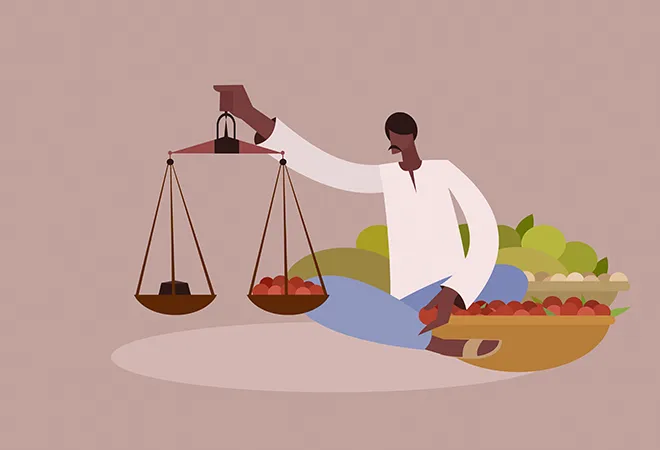
This article is part of the series — India–Bangladesh Relations @50: Commemorating Bilateral Ties.
Bangladesh shares 4,100 kilometres of its borders with India. Citizens of Bangladesh and India, especially those living in the two countries’ border areas, share many commonalities. These two countries have close ties in trade in goods and services, sharing water, cultural heritage, etc. Transport connectivity of all forms (water, rail, road, and air) between the two countries is a critical aspect of strengthening bilateral ties. The ‘border haats’ located on the zero line of the border between Bangladesh and India have also played a vital role in boosting connectivity and, above all, the Bangladesh-India bilateral relationship.
A border haat is ‘a rough-and-ready market’ allowing ‘local people to trade in locally-grown agricultural and manufactured’ items along the border. Currently, there are four border haats between Bangladesh and India. The first border haat was inaugurated in 2011 in the West Garo Hills district of the Indian state of Meghalaya at Kalaichar (India)–Kurigram (Bangladesh). Three other border haats followed — the Balat (India)–Dolora (Bangladesh) Haat in 2012; Srinagar (India)–Chhagalnaiya (Bangladesh), and Kamalasagar (India)–Kasba (Bangladesh) in 2015. With the experience of the positive impacts of those border haats on various economic and social aspects, both Bangladesh and India have sanctioned the establishment of six more border haats. They are also considering the prospects of a few more.
The core idea behind the border haats is to provide a formal arrangement of trade between the local communities of the two countries who have limited access to big markets, mainly due to long distances.
Bangladesh–India border haats are established within five kilometers on either side of the international border. They are restricted marketplaces that usually open once a week, where only local people with prior permission can enter and sell locally-produced goods. Usually, 500 people from both sides are allowed to enter the border haat on the weekly market day to purchase products duty-free. The haats allow consumers to make purchases up to US$ 200 on a single haat day and there is no customs duty.
The core idea behind the border haats is to provide a formal arrangement of trade between the local communities of the two countries who have limited access to big markets, mainly due to long distances. It is also argued that through the formalisation of cross-border trade by setting up border haats, it would be possible to reduce informal trading at the borders. The possibility to reduce informal trade would be higher if the scopes of trade can be expanded in the haat areas. Border haats also improve the relationship between the local people of both countries by creating business opportunities and facilitating interactions between them. They have opened new opportunities for women living in the border areas to sell products produced by them at a better price.
There is a need to resolve local problems that may not hit the headlines, but impact those people’s daily lives who are living in the border areas.
The border haats have not only opened a new horizon for trading, but they also have enabled people from both sides to revitalise old family bonds. These haats have created job opportunities for people in the adjacent areas. There has also been knowledge sharing. They have also promoted people-to-people connectivity — an essential building block in cementing ties between the two neighboring countries.
The focus of discussions between Bangladesh and India typically concentrates on big issues like water sharing and connectivity. These are long standing issues and progress towards cooperation has been slow. However, there is a need to resolve local problems that may not hit the headlines but impact those people’s daily lives who are living in the border areas. For example, both Bangladesh and India have ample trade potential along the border for agricultural and locally manufactured products. Both the countries need to work more towards materialising this potential. They can regularly organise border trade fairs on both sides, expanding transactions beyond the border haats. These small initiatives can have a far-reaching impact in building a stable relationship between India and Bangladesh and also help resolve the gaps in bigger issues. Connectivity through the border haats will eventually lead to more business opportunities for people of both countries and, thereby, an environment of trust and camaraderie will automatically be built. We have to realise that money and economic opportunities speak better than politics.
The views expressed above belong to the author(s). ORF research and analyses now available on Telegram! Click here to access our curated content — blogs, longforms and interviews.




 PREV
PREV


